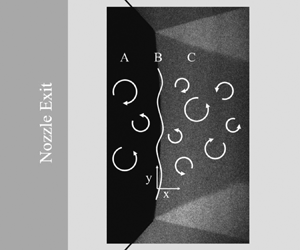Article contents
Velocity and temperature fluctuations in a high-speed shock–turbulence interaction
Published online by Cambridge University Press: 23 February 2021
Abstract

Shock-wave–turbulence interactions are important problems with ubiquitous applications in high-speed flight and propulsion. The complex physical processes during the interaction are not fully understood, where contemporary high-fidelity numerical simulations have brought into question classical linear interaction analyses (LIA). The differences are most pronounced at high Mach number ( $>$2). The objective of this study was to experimentally examine the role of a normal shock wave on the modification of velocity and temperature fluctuations to provide an empirical basis to help close the emerging knowledge gap between classical and contemporary theories. The experiments were performed in a pulsed wind tunnel facility at Mach 4.4. The free-stream disturbances provided the test bed for the study. A Mach-stem normal shock was generated through the interaction of two mirrored oblique shock waves. Molecular tagging velocimetry and two-line planar laser induced fluorescence thermometry were conducted upstream and downstream of the normal shock wave and the fluctuating intensities were compared. The measured axial velocity fluctuation amplification factor was nominally 1.1–1.2 over the Reynolds number range tested. The measured values were more consistent with LIA than contemporary theory. The temperature fluctuation amplification factor was found to vary between 3.0 and 4.5, where the lowest Reynolds number condition saw the highest free-stream disturbances and largest amplification. The free-stream fluctuations were primarily in the entropic mode, which is believed to lead to the significantly higher amplification of the entropic mode reported in these measurements.
$>$2). The objective of this study was to experimentally examine the role of a normal shock wave on the modification of velocity and temperature fluctuations to provide an empirical basis to help close the emerging knowledge gap between classical and contemporary theories. The experiments were performed in a pulsed wind tunnel facility at Mach 4.4. The free-stream disturbances provided the test bed for the study. A Mach-stem normal shock was generated through the interaction of two mirrored oblique shock waves. Molecular tagging velocimetry and two-line planar laser induced fluorescence thermometry were conducted upstream and downstream of the normal shock wave and the fluctuating intensities were compared. The measured axial velocity fluctuation amplification factor was nominally 1.1–1.2 over the Reynolds number range tested. The measured values were more consistent with LIA than contemporary theory. The temperature fluctuation amplification factor was found to vary between 3.0 and 4.5, where the lowest Reynolds number condition saw the highest free-stream disturbances and largest amplification. The free-stream fluctuations were primarily in the entropic mode, which is believed to lead to the significantly higher amplification of the entropic mode reported in these measurements.
JFM classification
Information
- Type
- JFM Papers
- Information
- Copyright
- © The Author(s), 2021. Published by Cambridge University Press
References
REFERENCES
- 13
- Cited by


